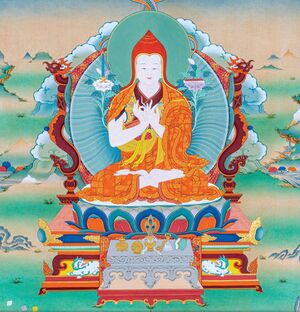Mipam Gyatso on Buddha-Nature[edit]
Ju Mipam Namgyal Gyatso (1846–1912) was perhaps the greatest polymath Tibet ever produced. A thinker and writer with extraordinary output, now published in 31/32 volumes, Mipam effectively began a new chapter of philosophical exegesis and scholarship in the Nyingma tradition. Although he did not claim to begin a new philosophical school but only elucidate and elaborate the points of the scholars and saints of the past, including his Nyingma precursors Rongzom Chökyi Zangpo (1042–1136) and Longchen Rabjam (1308–1364), Mipam became a trailblazer in presenting a clear Nyingma stance on many philosophical issues and is today seen as the most authoritative intellectual voice in the Nyingma tradition. While building a strong Nyingma philosophical and hermeneutic system, he also espoused and promoted the ecumenical rime approach and had much influence on other Tibetan Buddhist traditions through his writings.
Mipam did not write an extensive treatise on buddha-nature, although he discussed the topic in many of his writings. His writings on the Middle Way and Vajrayāna cover the topic of buddha-nature in some detail. However, it is in the two short writings, both with the title Lion's Roar, that we find his philosophical take on the definition of buddha-nature. The first one, Lion's Roar: Exposition of Buddha-Nature, is a pithy presentation in which Mipam explains the three rational arguments given in Ratnagotravibhāga, Verse I.28 for the presence of buddha-nature in all sentient beings. In the course of his discussion, Mipam refutes, on the one hand, the zhentong thought, which asserts buddha-nature to be an absolute hypostatic entity endowed with the qualities of the Buddha, and on the other, the Geluk position that buddha-nature refers to the mere negation of hypostatic existence as well as the Sakya assertion that it is the union of emptiness and clarity of the transient mind. Like his Nyingma precursors, whose position he sets out to elucidate, Mipam presents a description of buddha-nature which is closely related to the understanding of the "ground" in the Dzogchen philosophy. To him, buddha-nature is the coalescence of emptiness and luminosity, which is an unconditioned, innate nature of the mind. If analyzed using Mādhyamika reasoning, buddha-nature, like other phenomena, is empty of true self-existence and cannot be found. It defies ontological possibilities such as being, nonbeing, existence, nonexistence, both and neither. Yet, such emptiness or absence has a natural appearance or presence that is unconditioned and transcendent. Buddha-nature is this empty and transcendent nature, which all beings possess, and has all the qualities of enlightenment latent in it.
In his other short treatise, Lion's Roar: Affirming Other Emptiness, Mipam defends the zhentong interpretation of buddha-nature from the unjustified criticism made by the mainstream rangtong advocates. The proponents of rangtong, or self-emptiness theory, argue that buddha-nature refers to the emptiness of the mind and does not exist as an innate nature of a sentient being. They argue that the Buddha's teachings on buddha-nature as an innate state of enlightenment are not definitive teachings to be taken literally but provisional teachings to lead the beings who lack confidence. They criticized the proponents of zhentong, or other-emptiness, and accused them of espousing an absolutist concept akin to the non-Buddhist theory of self.
Although Mipam himself held the position of rangtong, or self-emptiness, which combines emptiness free from elaborations with unconditioned transcendent presence of enlightenment in all sentient beings, he rebutted the critique of zhentong theory. He used his two different schemes of two truths in order to do this: the two truths pertaining to emptiness and appearance (སྣང་སྟོང་བདེན་གཉིས་) and the two truths pertaining to existence and appearance (གནས་སྣང་བདེན་གཉིས་). In the context of the final analysis for true existence in accordance with the purport of the second turning of wheel, all things are empty. Thus, buddha-nature is also empty of its own nature as are all other things. Thus, buddha-nature is merely a conventional phenomena. Yet, in the context of what really exists on the conventional level in accordance with the purport of the third turning of the wheel, Mipam argues that there are some things which exist as they appear because they are inherent aspects of our true nature. Buddha-nature is such an inherent nature, and all sentient beings are endowed with the transcendent qualities of enlightenment in their true nature, unlike defiling emotions and negative thoughts of saṃsāra which are pure fiction and do not exist with any ontological reality. Thus, to Mipam, buddha-nature is empty of such adventitious problems, but not empty of its own transcendent qualities.
Weekly quote[edit]
The single essential point of all the doctrines of Sūtra and Mantra is only this all-pervasive buddha-nature.~ Mipam Gyatso (1846–1912)

